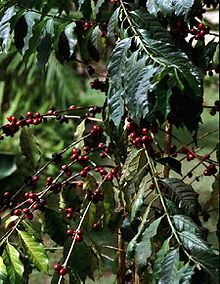- Coffee production in Bolivia
-
 Coffee plant in Yungas, Bolivia.
Coffee plant in Yungas, Bolivia.
Coffee production in Bolivia has had a long history in the country. Coffee is grown in regions of 800–2,300 metres (2,600–7,500 ft) above the sea level.[1]
History
- 19th century
Bolivia did not export as much coffee as the neighboring countries. The best coffee produced Yungas, which rivals Cafe mocha. The departments of La Paz, Cochabamba, Santa Cruz, and El Beni are the principal areas which produced coffee; the most notable areas were the districts of Yungas, Caupalicam, Espiritu Santo, and Valle Grande. There was a time in which the Yungas coffee had a great demand, especially so in Europe. This Asiatic plant is so well acclimatized in Yungas that it grows spontaneously, for each grain which falls on the ground becomes a tree. In 1885, the production of coffee was 2,400,000 pounds a year. By 1900, at La Paz, a machine was installed to roast and grind coffee, selling it in home-made tins.[1]
- Early 20th century
Production in 1908 was 1,500,000 pounds. About 150,000 pounds were exported annually; most of it is consigned to Chile.[2]
References
- This article includes text incorporated from Pan American Union's "Coffee: extensive information and statistics" (1902), a publication now in the public domain.
- This article includes text incorporated from H.C. Graham's "Coffee: Production, trade, and consumption by countries" (1912), a publication now in the public domain.
- ^ a b Pan American Union (1902). Coffee: extensive information and statistics (Public domain ed.). Govt. Print. Off.. pp. 24–. http://books.google.com/books?id=yvYaAAAAYAAJ&pg=PA21. Retrieved 16 November 2011.
- ^ Graham, Harry Crusen (1912). Coffee: Production, trade, and consumption by countries. Govt. print. off.. pp. 36–. http://books.google.com/books?id=Evbp7CWh0EEC&pg=PA36. Retrieved 17 November 2011.
Coffee Topics - Economics
- Fair trade
- Health effects
- History
Production by
countrySpecies and
varietiesMajor
componentsProcessing Preparation Popular
beverages- Affogato
- Americano
- Bicerin
- Cà phê sữa đá
- Café au lait
- Café con leche
- Café Cubano
- Cafe mocha
- Caffè corretto
- Caffè macchiato
- Cappuccino
- Carajillo
- Coffee milk
- Cortado
- Espresso
- Flat white
- Frappuccino
- Galão
- Greek frappé coffee
- Iced coffee
- Indian filter coffee
- Ipoh white coffee
- Irish coffee
- Kopi Luwak
- Latte
- Latte macchiato
- Liqueur coffee
- Long black
- Red eye
- Ristretto
- Turkish coffee
Substitutes Lifestyle  Bolivia topics
Bolivia topicsHistory Geography Departments · Provinces · Cities · Lakes · Mountains · Volcanoes · Rivers · Climate · Environmental issues · Extreme pointsPolitics President · Government · Political parties · Elections · Constitution · Foreign relations · Military · Law enforcement · Human rights (LGBT rights)Economy Tourism · Boliviano · Communications · Transport · Energy · Sanitation · Health · International rankingsDemographics Culture Other topics Index • PortalCategories:- Economy of Bolivia
- Coffee production by country
Wikimedia Foundation. 2010.
